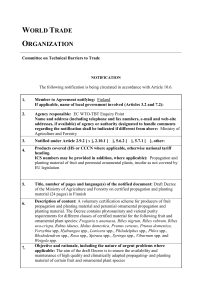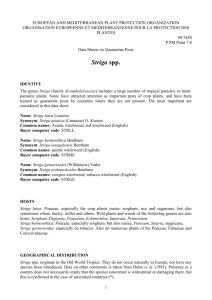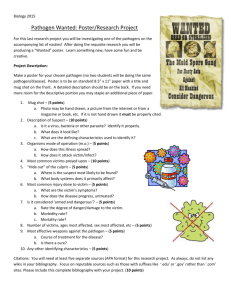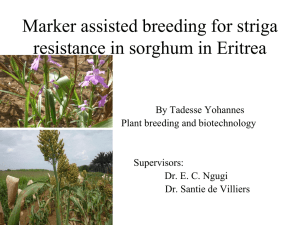CPD POWER-POINT - University of Nairobi
advertisement
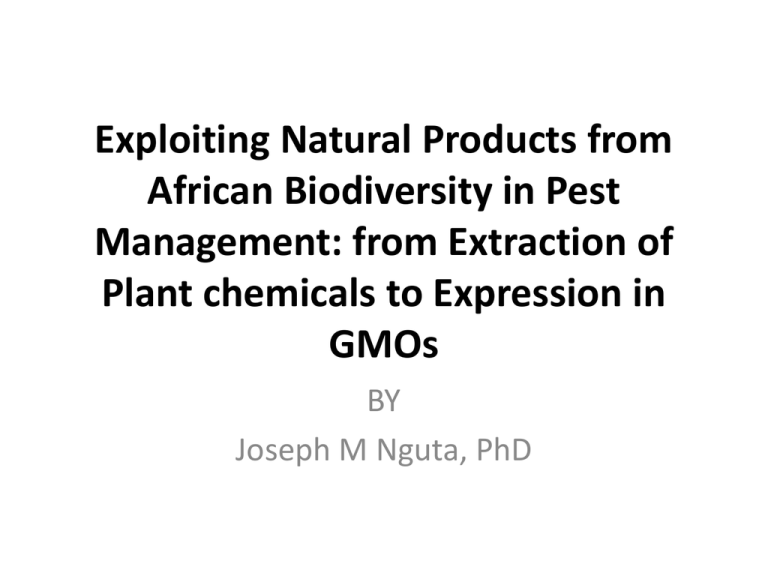
Exploiting Natural Products from African Biodiversity in Pest Management: from Extraction of Plant chemicals to Expression in GMOs BY Joseph M Nguta, PhD Introduction • Natural products have for long provided leads for pesticides (especially insecticides) • Classic examples include:neonicotinoids; Spinosad • Also natural products from the pyrethrum daisy, Chrysanthemum (= tanacetum) cinerariifolium (Asteraceae): permethrin, cypermethrin and deltamethrin Introduction • By exploiting African biodiversity, compounds can be identified for exploitation locally and internationally in pest management • Natural products with biopesticidal potential will be discussed. Repellents against insect vectors of pathogens • • • • • Natural products in this category include: Neonicotinoids Pyrethroids Metofluthrin eucamalol from Eucalyptus camaldulensis (Myrtaceae) • Ocimum spp (Lamiaceae) Repellents against insect vectors of pathogens • Gum haggar from Commiphora holtziana • (Burseraceae)-highly active against ticks and mites attacking cattle and camels Antifeedants against crop pests • Natural products with potential to yield antifeedants against crops include: • Ajuga spp. (Lamiaceae), particularly A. remota, yielding ajugarin 1 • The tree Warburgia ugandensis (Canellaceae), yielding ugandensidial • However, although these could be used locally and also form the basis of exports to the north, such products have not yet been exploited. (Pickett et al. 1987). Direct production of crop protection agents by companion crops • Natural products in this category include: • Forage legumes in the genus Desmodium (Fabaceae), which also dramatically controls the African parasitic witch weeds in the genus Striga (Orobanchaceae), particularly S. hermonthica • Each companion crop is also used as forage for cattle or dairy goats (Khan et al. 1997; Hassanali et al. 2008) Release from GM plants • By identifying the chemistry of the companion crops that is responsible for repelling pests and attracting beneficial insects, new targets for genetic modification, for example, increasing production of 4,8,12-trimethyl(E,E)-trideca-1,3,7,11-tetraene which both repels pests and attracts parasitic wasps have been identified Release from GM plants • Currently, research is ongoing on elicitors from the eggs of maize stem borers to identify elicitors that can have dramatic effects on the defense chemistry of African grasses (Bruce et al. 2010). • The compounds from Desmodium uncinatum that interfere with the development of the parasitic weeds Striga spp. comprise C-glycosylated flavonones and recently, the mechanism by which these compounds are biosynthesised (Hamilton et al. 2009) has been elucidated Release from GM plants • By heterologously expressing the Cglycosyltransferase enzymes involved into edible beans, it is possible to create companion intercrop plants useful as human food but embodying the novel trait for controlling Striga spp. (Pickett et al. 2010; Khan et al. 2010). Acknowledgements • CPD secretariat, PHPT (For facilitating my participation) • Dr. Mbaria (For his useful criticism) • University of Nairobi (for giving me an opportunity to serve in this World Class University) • Dr. S.G.Kiama (for provision of visionary leadership in natural product research)




